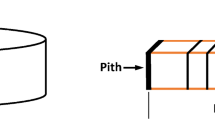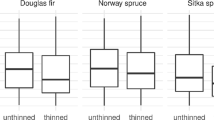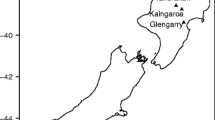Abstract
Peripheral longitudinal growth strain (LGS) was measured on a total of 81, 22-year-old pruned Eucalyptus nitens trees from five thinning treatments in a plantation thinning trial in Tasmania. Growth strain data were gathered at breast height on each tree using the CIRAD-Forêt method. The effects of thinning treatment and tree diameter on LGS and its relationships to solid-wood traits determined in a processing trial were examined. LGS was significantly higher in the direction of the prevailing wind and was not significantly affected by either thinning treatment or tree diameter. An index of log end splitting was positively related to tree diameter, sawlog position (upper/lower), and LGS, which explained up to an additional 20% of the variance after tree diameter and log position were accounted for in a linear regression model. High LGS and log end splitting were significant indicators of increased board end splitting.


Similar content being viewed by others
References
Aggarwal PK, Chauhan S, Karmarkar A (2002) Variation in growth strain, volumetric shrinkage and modulus of elasticity and their inter-relationships in Acacia auriculaeformis. J Trop For Prod 8(2):135–142
Baillères H, Yang J, Muneri A, Ognouabi N (2003) Growth strains assessment of various Eucalyptus species by near infrared spectroscopy. Paper presented at the proceedings of IUFRO all division 5 conference: forest products research—providing for sustainable choices, Rotorua, New Zealand
Baker T, Volker P (2007) Silviculture of eucalypt plantations in southern Australia for high-value solid wood products. Ciencia e Investigación Forestal 13(1):43–57
Benjamini Y, Hochberg Y (1995) Controlling the false discovery rate: a practical and powerful approach to multiple testing. J R Stat Soc B 57(1):289–300
Brennan GK, Hingston RA, Moore RW (2004) Processing 17-year-old Tasmanian blue gum sawlogs grown at wide spacing. Aust For 67(4):240–246
Cardoso AA, Trugilho PF, Lima JT, Rosado SC, Mendes LM (2005) Longitudinal residual strain in different spacing and ages in hybrid clone of Eucalyptus. Cerne 11(3):218–224
Chafe SC (1985) Variation in longitudinal growth stress with height in trees of Eucalyptus nitens Maiden. Aust For Res 15(1):51–55
Chauhan SS, Walker J (2004) Relationships between longitudinal growth strain and some wood properties in Eucalyptus nitens. Aust For 67(4):254–260
de Fégely R (2004) Sawing regrowth and plantation hardwoods with particular reference to growth stresses. Part A: literature review. Report Project no. PN02.1308. Forest and Wood Products Research Development Corporation, 44 pp
Ferrand JC (1983) Growth stresses and silviculture of eucalypts. Aust For Res 13(1):75–81
Lima IL, Garcia JN, Nogueira MCS (2000) Influence of thinning on the Eucalyptus grandis Hill ex-Maiden growth stress. Scientia Forestalis 58:111–125
Lima I, Garcia J, Stape J, De Stefano Piedade SM (2006) Efeito do desbaste e da fertilização nas tensões de crescimento em Eucalyptus grandis. Scientia Forestalis 70:171–183
Malan F (1995) Eucalyptus improvement for lumber production. Paper presented at the Seminário internacional de utilização da madeira de eucalipto para serraria São Paulo
McKenzie HM, Shelbourne CJA, Kimberley MO, McKinley RB, Britton RAJ (2003) Processing young plantation-grown Eucalyptus nitens for solid-wood products. 2: predicting product quality from tree, increment core, disc, and 1-m billet properties. N Z J For Sci 33(1):79–113
Medhurst J, Ottenschlaeger M, Wood M (2007) Crown symmetry and stem shape in a Eucalyptus nitens plantation in relation to intra-specific competition. Technical Research Report 169. CRC for Forestry, Hobart, Tasmania, 30 pp (unpublished data)
Muneri A, Leggate W, Palmer G (1999) Relationships between surface growth strain and some tree, wood and sawn timber characteristics of Eucalyptus cloeziana. S Afr For J 186:41–50
Murphy TN, Henson M, Vanclay JK (2005) Growth stress in Eucalyptus dunnii. Aust For 68(2):144–149
Nolan G, Greaves B, Washusen R, Parsons M, Jennings S (2005) Eucalypt plantations for solid wood products in Australia—a review: if you don’t prune it, we can’t use it. Project no: PN04.3002. Forest and Wood Products Research and Development Corporation Victoria, Australia, 130 pp
Nutto L, Touza M (2004) High quality Eucalyptus sawlog production. Paper presented at the Eucalyptus in a changing world. In: Proceedings of international union of forestry research organisations conference, Aveiro, Portugal, 11–15 October
Nutto L, Spathelf P, Selling I (2006) Management of individual tree diameter growth and implications for pruning for Brazilian Eucalyptus grandis Hill ex Maiden. Floresta e Ambiente 36(3):397–413
Raymond CA, Kube PD, Pinkard L, Savage L, Bradley AD (2004) Evaluation of non-destructive methods of measuring growth stress in Eucalyptus globulus: relationships between strain, wood properties and stress. For Ecol Manag 190(2–3):187–200
SAS Institute Inc (2004) SAS® 9.1.2. Qualification Tools User’s Guide
SAS Institute Inc (2005) The GLIMMIX procedure, November 2005. http://support.sas.com/rnd/app/papers/glimmix.pdf
Schall R (1991) Estimation in generalized linear models with random effects. Biometrika 78:719–727
Standard Australia (1999) AS2796.1 timber–hardwood–sawn and milled products. Part I: product specifications. Standards Australia, Sydney, p 43
Telles P (2002) Avaliação de características tecnológicas de madeira para serraria em progênies de polinização aberta de eucalipto e implicações para o melhoramento genético, vol 27. Escola Superior de Agricultura Luiz de Queiroz (ESALQ), 153 pp
Touza M (2001) Sistemas de aserrado adecuados para Eucalyptus globulus europeos afectados por tensiones de crecimiento in Proyecto FAIR CT 98-9579 CIS-Madera. http://www.cismadeira.com/castelan/downloads/craft.pdf
Trugilho P, Iwakiri S, Rocha M, Matos J, Saldanha L (2004) Age and diametric class effects on longitudinal residual strain in Eucalyptus dunnii trees. Revista Arvore 28(5):725–731
Trugilho P, Lima J, de Pádua F, de Carvalho L, Andrade C (2006) Deformação residual longitudinal (DRL) e tangencial (DRT) em seis clones de Eucalyptus spp. Cerne 12(3):279–286
Trugilho PF, Bianchi ML, Da Silva Rosado SC, Lima JT (2007) Wood quality of natural hybrid and species of Eucalyptus clones. Scientia Forestalis 73:55–62
Valdés R (2004) Determinación de tensiones crecimiento de Eucalyptus nitens mediante método no destructivo. Memoria de titulo para optar al grado de ingeniero en industrias de la madera, Universidad de Talca, Chile, Talca, Chile, 48 pp
Verryn S, Snedden CL, Wessels B (2005) Consideration of wood quality traits in the prediction of Eucalyptus grandis sawtimber recovery and veneer value recovery in South Africa. Paper presented at the XXII IUFRO world congress. Forest in the balance: linking tradition and technology. The International Forestry Review, Brisbane, Australia
Washusen R, Harwood CE, Morrow A, Northway RL, Valencia JC, Volker PW, Wood M, Farrell R (2009) Pruned plantation-grown Eucalyptus nitens: effect of thinning and conventional processing strategies on sawn board quality and recovery. N Z J For Sci 39:39–55
Wilkins AP, Kitahara R (1991) Silvicultural treatments and associated growth rates, growth strains and wood properties in 12.5-year-old Eucalyptus grandis. Aust For 54(1–2):99–104
Yang JL (2005) The impact of log-end splits and spring on sawn recovery of 32-year-old plantation Eucalyptus globulus Labill. Holz Roh-Werkst 63(6):442–448
Yang J (2007) Investigation of potential sawlog quality indicators—a case study with 32-year-old plantation Eucalyptus globulus Labill. Holz Roh-Werkst 65(6):419–427
Yang JL, Fife D (2003) Identifying check-prone trees of Eucalyptus globulus Labill. using collapse and shrinkage measurements. Aust For 66(2):90–92
Yang J, Pongracic S (2004) The impact of growth stress on sawn distortion and log end splitting on 32-year-old plantation blue gum. Project no: PN03.1312. Forest and Wood Products Research Development Corporation, 31 pp
Yang JL, Waugh G (2001) Growth stress, its measurement and effects. Aust For 64(2):127–135
Yang JL, Fife D, Matheson AC (2001) Growth strain in three provenances of plantation-grown Eucalyptus globulus Labill. Aust For 64(4):248–256
Yang JL, Fife D, Waugh G, Downes G, Blackwell P (2002) The effect of growth strain and other defects on the sawn timber quality of 10-year-old Eucalyptus globulus Labill. Aust For 65(1):31–37
Yang JL, Baillères H, Okuyama T, Muneri A, Downes G (2005) Measurement methods for longitudinal surface strain in trees: a review. Aust For 68(1):34–43
Yang JL, Bailleres H, Evans R, Downes G (2006) Evaluating growth strain of Eucalyptus globulus Labill. from SilviScan measurements. Holzforschung 60(5):574–579
Acknowledgments
We thank Tony Jaeger and Brett McKay of McKay Timbers, for making their St Helens and Glenorchy sawmills available for the processing trial and ITC Timbers for carrying out drying of some of the boards. Dion McKenzie of Forestry Tasmania provided invaluable assistance during the tree selection and field harvesting phases of the trial. Trevor Innes, then of the University of Tasmania, also helped with the harvesting and processing phases. We thank Emlyn Williams of the Australian National University for statistical advice.
Author information
Authors and Affiliations
Corresponding author
Rights and permissions
About this article
Cite this article
Valencia, J., Harwood, C., Washusen, R. et al. Longitudinal growth strain as a log and wood quality predictor for plantation-grown Eucalyptus nitens sawlogs. Wood Sci Technol 45, 15–34 (2011). https://doi.org/10.1007/s00226-010-0302-1
Received:
Published:
Issue Date:
DOI: https://doi.org/10.1007/s00226-010-0302-1




